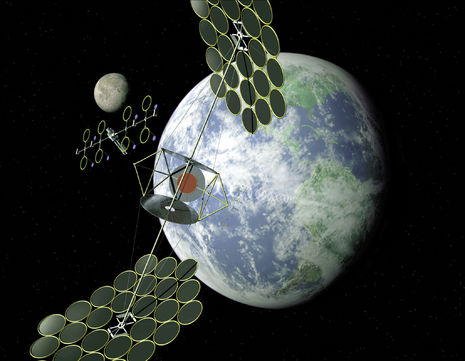Space-based solar power prepares for takeoff
Miranda Lepri details the Cavendish Laboratory’s role in the future of space-based solar power

As crazy as it may seem, the possibility of launching solar farms in space is becoming more science than fiction. As of this June, the University of Cambridge is one of eight institutions to receive grant funding from the UK government’s Space Based Solar Power Innovation Competition. The competition is part of the Net Zero Innovation Portfolio, which allocates funding to the development of low-carbon or renewable technologies and systems in order to realise the set goal of net zero emissions by the year 2050.
While solar energy has long been floated as a potential alternative to combustibles, several factors have stood in the way of its viability in eclipsing carbon-based fuel as a major energy source. For one thing, solar panels on Earth, particularly residential cells, often operate at somewhere between 17% and 20% efficiency, with the most advanced recent developments reaching closer to 50%. This is due to a variety of factors, not least including variations in weather conditions and limited daylight hours.
None of these would be factors in space, where a satellite in geostationary orbit about 36,000km above the Earth’s surface could continuously generate energy close to 24 hours a day. While most mid-sized solar plants, which includes all solar farms in the UK, cap out annual production in megawatts, space-based solar plants would easily deal in gigawatts – for context, one gigawatt (GW) is equivalent to 1,000 megawatts, and a potential 10GW annual generation capacity would account for ¼ of the UK’s net electricity consumption. Space solar farms would also greatly reduce the sheer amount of land required to generate solar power, with the UK’s largest solar farm inhabiting over 250 acres for a mere 72.2-megawatt maximum output.
“Space solar farms would greatly reduce the sheer amount of land required to generate solar power”
When considered in these terms, space-based solar farms seem too good to be true. The technology is not without its downsides though, chief among them the longevity of the hardware in space, an environment which presents accessibility issues, as well as potentially prohibitive costs, when considering potential repairs. This is where the new research out of Cambridge comes in.
In partnership with programs at the University of Southampton and IQE PLC, a British company dealing in cutting-edge semiconductors, Cambridge’s Cavendish Laboratory is developing lightweight solar panels that will not deteriorate in the face of high levels of solar radiation. Louise Hirst, Professor of Material Physics at the University, and her team are currently working on the production of concentrator photovoltaic devices – solar technology that converts light into electrical energy – that are able to resist deterioration from radiation due to their ultra-thin nature and the implementation of integrated light management technology.
The ultra-thin solar cells resist degradation better than their thicker counterparts, as the charged particles carrying solar energy travel a shorter distance across the cell, offering fewer opportunities for the particles to strike, and thus degrade, the solar panel’s crystal structure. While thinner cells do have higher transmission losses, the addition of internal light management structures, such as textured, reflective surfaces within the solar cell, would help to optimise the solar panels’ energy production. The team will also apply a thin film coating to the prototypes, allowing the device to regulate its temperature by releasing excess heat into space.
“The same science that heats up your pot ramen could transport gigawatts of solar energy from orbit to the Earth’s surface”
Professor Hirst’s team is also working to minimise the costs of this new technology, enabling what Hirst described in a University press release as “a complete, technically feasible, robust, and relatively inexpensive solution for generating power from space”. The general decreasing trend in the cost of launching heavy cargoes into orbit will also ease the start-up cost of space-based solar farms in the coming years.
The potential for energy generation in space seems highly promising. This raises the question, though – how will this energy be transported back to Earth? The answer is, shockingly enough, microwaves. That’s right – the same science that heats up your pot ramen could transport gigawatts of solar energy from orbit to the Earth’s surface. Just this year, researchers at Caltech launched a prototype spacecraft and successfully transmitted solar power to Earth through the use of microwave technology.
To justify the costs of space-based solar farms, this technology must become highly efficient, rather than merely technologically viable, by retaining a significant portion of the energy generated in the transfer. This technology will need to develop alongside Hirst and her team’s lightweight panels in order to make space-based solar power a feasible source of renewable energy. The technology may not be ready to launch tomorrow, but for a 24-hour completely renewable energy source, with little to no carbon footprint here on Earth? We’re willing to wait.
 News / Cambridge study finds students learn better with notes than AI13 December 2025
News / Cambridge study finds students learn better with notes than AI13 December 2025 News / Uni Scout and Guide Club affirms trans inclusion 12 December 2025
News / Uni Scout and Guide Club affirms trans inclusion 12 December 2025 News / Cambridge Vet School gets lifeline year to stay accredited28 November 2025
News / Cambridge Vet School gets lifeline year to stay accredited28 November 2025 Comment / The magic of an eight-week term15 December 2025
Comment / The magic of an eight-week term15 December 2025 Features / Should I stay or should I go? Cambridge students and alumni reflect on how their memories stay with them15 December 2025
Features / Should I stay or should I go? Cambridge students and alumni reflect on how their memories stay with them15 December 2025









